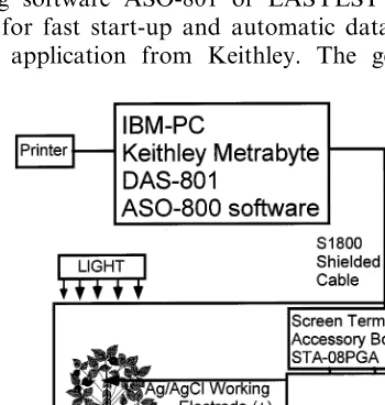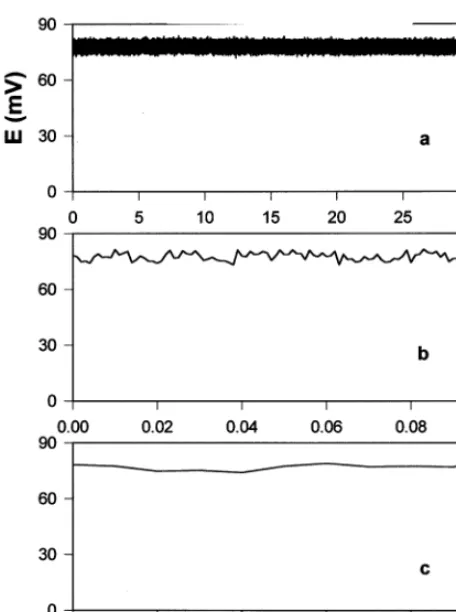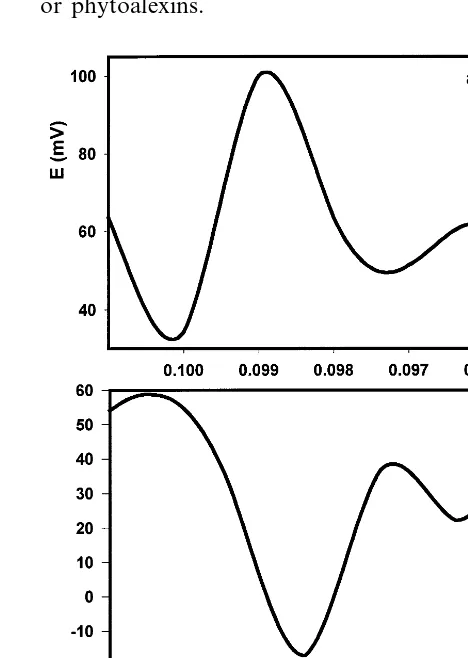Plant electrophysiology: pentachlorophenol induces fast action
potentials in soybean
Alexander G. Volkov
a,*, Daniel J. Collins
b, John Mwesigwa
aaDepartment of Chemistry,Oakwood College,Hunts6ille,AL35896,USA
bDepartment of Soil and Plant Sciences,Urban Forestry Program,Southern Uni6ersity,Baton Rouge,LA,USA
Received 21 September 1999; received in revised form 7 December 1999; accepted 15 December 1999
Abstract
In the present work, we show that pentachlorophenol (PCP) induces ultra fast action potentials and decreases the variation potential in a soybean. The speed of the propagation of action potentials in a soybean induced by PCP reaches up to 30 m/s, similar to excitation propagation in animal nerves. Measured velocities for transmission of action potentials in green plants reported by different authors were registered in the range of a few mm/s. Action potentials induced in soybeans by PCP are many times faster. Seventy hours after adding PCP to soil variation (resting) potential decreases to zero level. This is the first attempt of high-speed automatic measurements of fast action potentials in green plants. © 2000 Elsevier Science Ireland Ltd. All rights reserved.
Keywords:Plant electrophysiology; Action potential; Uncoupler; Pentachlorophenol
www.elsevier.com/locate/plantsci
1. Introduction
The processes of life have been found to gener-ate electric fields in every organism that has been examined with suitable and sufficiently sensitive measuring techniques [1]. The electrochemical con-duction of excitation over specialized structures must be regarded as one of the most universal properties of living organisms [2]. It arose at the early stages of evolution in connection with the need for transmission of a signal about an external influence from one part of a biological system to another [3]. Study of the nature of regulatory relations of the plant organism with the environ-ment is a basic electrophysiological problem, one that has a direct bearing on the task of controlling the growth and development of plants [4,5].
Every living cell continuously receives informa-tion about its surroundings. Its surface membrane
has numerous protein receptors, which interact with practically all vitally important molecules [6]. Plants have a specific property, which is excitabil-ity. This property is used by cells, tissues, and organs to change their internal condition and ex-ternal reactions under the action of various envi-ronmental factors, referred to as irritants [7]. Volkov and Haack [8] studied the role of electrical signals induced by insects in long-distance commu-nication in plants and confirmed the mechanism by which electrical signals can directly influence both biophysical and biochemical processes in re-mote tissues.
Action potentials in higher plants are the infor-mation carriers in intercellular and intracellular communication in the presence of environmental changes. Plants are exposed to a diversity of con-tinuously varying perturbations, including air and soil pollution. The presence of pentachlorophenol (PCP) in the soil is the most serious en-vironmental problem and has a hazardous impact on agriculture and human health. PCP is known as a protonophore or uncoupler of oxidative Abbre6iations:PCP, pentachlorophenol.
* Corresponding author. Fax: +1-256-7267111.
E-mail address:[email protected] (A.G. Volkov)
phosphorylation in bioenergetics [9]. It is a pollu-tant and the largest chemical source of dioxins to the environment. PCP is also used as a herbicide, insecticide, and fungicide. PCP is a member of the substituted halogenated aromatic family of pesti-cides, many of which exhibit insecticide and fungi-cide activity. In addition, PCP and its products are toxic to plants, making them useful as defoliants and general herbicides. Primary uses of PCP in-clude protection of timber from fungal rot and wood-boring insects. The mechanism of action of PCP is believed to be the inhibition of the forma-tion of ATP by uncoupling oxidative phosphoryla-tion. Presently, we have been able to show that PCP induces fast action potentials and decreases the variation potential to zero level in soybeans.
2. Materials and methods
All electrical measurements were conducted in-side a Faraday cage (Fig. 1). Ag/AgCl electrodes were connected to a voltmeter/pH meter Cole Palmer Microcomputer pH-vision Model 05669-20. An IBM-compatible microcomputer with a multi I/O plug-in data acquisition board DAS-801 (Keithley MetraByte) was interfaced with the volt-meter and used to record the digital data. The measuring signals were recorded as ASCII files using software ASO-801 or EASYEST AG-tool kits for fast start-up and automatic data acquisi-tion applicaacquisi-tion from Keithley. The generaacquisi-tion
and propagation of action potentials and electrical impulses between the tissues in higher plants can be measured by reversible nonpolarizable elec-trodes [10]. For potential difference measurements we used nonpolarizable reversible Ag/AgCl-elec-trodes with a diameter of 0.14 mm as the reference and the working electrodes connected to an
elec-trometer and interfaced with the computer
through a multiplexed screw terminal accessory board STA-08 (Keithley). Ag/AgCl electrodes were prepared from a Teflon coated silver wire (A-M Systems, Inc.) according to the method de-scribed by Ksenzhek and Volkov [4]. Since both Ag/AgCl electrodes are identical, we decided to call one a reference and the other a working electrode as shown in Fig. 1. The reference elec-trode (−) was inserted in the stem or root of a soybean. The working electrode (+) was inserted in to the stem or leaf of a soybean.
Three-week-old soybean seedlings (Glycine max (L.) Merrill), cultivar Hutchenson were used in all studies; such plants usually had five and six well-developed leaves. Plants were grown in a growth chamber (Environmental Corporation) at 28°C with a 12:12 h light:dark photoperiod in clay pots with sterilized potting soil. The plants were given water every other day and kept at 24°C. PCP was obtained from Fluka (New York, NY). All experi-mental data were repeated at least 10 times. Ac-tion potential generaAc-tion induced by PCP was measured at least 1000 times.
3. Results and discussion
Following insertion of the electrodes, the plants were allowed to rest until a stable potential differ-ence was obtained between the working and refer-ence electrodes. Insertion of electrodes in plants induces action potentials across the stem and slow fluctuations of the variation potential. After ap-proximately 1 and 2 h, the variation potential
stabilizes, and action potentials induced by
wounding disappear [8]. Fig. 2 shows variation potential in soybean before any treatment of the plant.
When the soil is sufficiently wet, further addi-tion of water to soil or spraying of water on the leaves does not result in generation of action potentials or essential changing of the variation potential. If the soil had not been watered for a
Fig. 2. Potential difference between two Ag/AgCl electrodes in the stem of soybean before any treatment of the plant. Distance between electrodes was 8 cm. The soil was prelimi-nary treated by water every day. Volume of soil was 0.5 l. The soil around a plant was treated with water every day. Room temperature was 24°C. Figures b and c show short time intervals of Figure a.
first peak (Fig. 5). During this process the poten-tial of the reference electrode changes with regard to the working electrode. The duration of single action potentials, after treatment by PCP, is 2 ms. The amplitude of action potentials is about 60 mV. After treatment of soil by an aqueous solu-tion of PCP, the variasolu-tion potential measured between two Ag/AgCl microelectrodes in the stem of a soybean, slowly decreased from 75 to 85 mV (− in a root, + on the top of soybean) to zero during 48 h. Fig. 3 shows action potentials in soybeans after the first 24 h after of soil treatment by PCP. During the second day, action potentials reached an amplitude about 60 mV, duration time 2 ms, and propagation speed of 10 m/s generate in a soybean. After 48 h variation potential stabilizes at zero level and fast action potentials with ampli-tude at about 60 mV, duration time of 2 ms, and propagation speed of 30 m/s generate in soybean
Fig. 3. Potential difference between two Ag/AgCl electrodes in the stem of soybean 24 h after adding 50 ml of 5×10−4M
PCP to soil. Distance between electrodes was 8 cm. The plants were given water every other day and kept at 24°C. Volume of soil was 0.5 l. Figures b and c show short time intervals of Figure a.
few days, water stress on the plant may have been observed.
Fig. 4. Potential difference between Ag/AgCl electrode in the stem and Ag/AgCl electrode in a root of soybean measured 70 h after adding 50 ml of 5×10−4M PCP to soil. Distance
between Ag/AgCl electrodes was 9 cm. The plants were given water every other day and kept at 24°C. Volume of soil was 0.5 l. Figures b, c and d shows short time intervals of Figure a.
tion potentials take an active part in the expedient character of response reactions of plants as a reply to external effects. These impulses transfer a signal about the changes of conditions in a conducting bundle of a plant from the root system to the point of growth and conversely. The response reactions of plant tissues and organs can be local, or transmitted from cell-to-cell over long distances via the plasmodesmata. Excitation, due to electri-cal impulses generated by changes in
environmen-tal conditions, functions as a carrier of
information in soybean. The speed of propagation of electrical signals is sufficiently high to facilitate rapid long-distance communication and accounts for the rapid response phenomena observed in plants. This has implications for how plants com-municate to elicit the production of stress proteins or phytoalexins.
Fig. 5. Determination of the speed of action potentials in soybean by measuring potential difference between two Ag/
AgCl electrodes in the stem of soybean 24 h after adding 50 ml of 5×10−4 M PCP to the soil. Distance between
elec-trodes was 8 cm. The plants were given water every other day and kept at 24°C. Volume of soil was 0.5 l. Figures a and b were taken from Fig. 3a.
(Fig. 4b – d). Duration time of action potentials and speed of excitation propagation does not de-pend on the distance between working and refer-ence electrodes. The speed of propagation of action potentials was measured as the distance between Ag/AgCl electrodes divided by time be-tween positive and negative peaks of action poten-tials (Fig. 5).
Ac-Action potentials are signals caused by the de-polarization of the plasma membrane. Mechani-cal, physiMechani-cal, or chemical external irritants act not only at the place of occurrence, but the excitation can be also transferred along the whole plant. The speed of excitation transfer depends on many fac-tors, such as the intensity of the irritation,
temper-ature, chemical treatment or mechanical
wounding, and is also influenced by previous exci-tations. The excitation reaction goes in both direc-tions, from the top of a stem to the roots and conversely. The condition of excitation has a com-plicated character, accompanied by an internal change in cells and tissues. The most rapid meth-ods of long distance communication between plant tissues and organs are bioelectrochemical or elec-trophysiological signals. Effectiveness of such long-distance communication is clear since plants can rapidly respond to external stimuli (e.g. changes in temperature or osmotic environment,
plant pathogens, insects, illumination level,
wounding, cutting, mechanical stimulation or wa-ter availability), and changes can be detected in distant parts of the plant soon after the injury. Volkov and Haack [8] studied the role of electrical signals induced by insects in long-distance commu-nication in plants and confirmed the mechanism by which electrical signals can directly influence both biophysical and biochemical processes in re-mote tissues. Mizuguchi et al. [11] found out that the application of ac voltage to the cultured solu-tion accelerates a soybean growth rate by 30%. The authors considered such an accelerating effect to be related to the stimulation of the ion pumps for growth metabolism.
Measured velocities for propagation of action potentials in green plants, which have been re-ported by different authors, include (see for review [4]), 20 cm/s in Dionaea flytrap, 4.4 cm/s in Mi
-mosa pudica leaf stalk, 5 mm/s in Drosera, 1.8 cm/s following cold stimulation in Cucurbita pepo, 0.5 – 0.8 mm/s in etiolated pea plants that were wounded, up to 10 cm/s via sieve tubes in Cucur
-bita pepo, and 1 – 7 mm/s in response to wounding. Action potentials induced in soybean by PCP are much faster, of the order of 30 m/s (Figs. 3 and 4). Similar data were obtained in experiments with other uncouplers — 2,4-dinitrophenol and FCCP [12 – 14].
Action potentials are surprisingly common in higher plants and lower eucaryotes. Most of the
characterization of action potentials has used in-tracellular measurements of single cells and fo-cused on the identification of the ion fluxes underlying the action potentials. The cells of many biological organs generate an electric potential that may result in the flow of electric current. Electrical impulses may arise spontaneously or they may result from stimulation. Once initiated, they can propagate to adjacent excitable cells. The change in transmembrane potential creates a wave of depolarization, or action potential, that affects the adjoining, variation membrane. Thus, when the phloem is stimulated at any point, the action potential is propagated along the phloem with fixed amplitude. Once initiated, the action poten-tial has a standard form and an essenpoten-tially fixed amplitude — an ‘all or none’ response to a stimu-lus. The propagation of each impulse is followed by the absolute refractory period during which the fiber cannot transmit a second impulse. The high sensitivity of protoplasm and all cell organelles to any natural and chemical effects is the basis for excitability. The integral organism of a plant can be maintained and developed in a continuously varying environment only if all cells, tissues and organs function in concordance. Plants continu-ously adjust to the external world. The co-ordina-tion of internal processes and their balance with the environment are connected with the excitabil-ity of plant cells. The automatic measurements of the electrical potential difference can be effectively used in environmental plant electrophysiology, for the studying of molecular mechanisms of ion transport and the influence of external stimuli on plants.
Acknowledgements
Financial support from the National Science Foundation and the Executive Leadership Foun-dation (Technology Transfer Project) is gratefully acknowledged.
References
[1] J.C. Bose, Transmission of stimuli in plants, Nature 115 (1925) 457.
[3] A. Goldsworthy, The evolution of plant action potentials, J. Theor. Biol. 103 (1983) 645 – 648.
[4] O.S. Ksenzhek, A.G. Volkov, Plant Energetics, Academic Press, San Diego, 1998.
[5] T. Sibaoka, Excitable cells in Mimosa, Science 137 (1962) 226 – 228.
[6] A.G. Volkov (Ed.), Liquid Interfaces in Chemical, Biolog-ical, and Pharmaceutical Applications, Marcel Dekker, New York, in press.
[7] A.M. Sinukhin, E.A. Britikov, Action potentials in the reproductive system of plant, Nature 215 (1967) 1278 – 1280.
[8] A.G. Volkov, R.A. Haack, Insect induces bioelectrochem-ical signals in potato plants, Bioelectrochem. Bioenerg. 35 (1995) 55 – 60.
[9] L.S. Yaguzhinsky, L.I. Boguslavsky, A.G. Volkov, A.B. Rakhmaninova, Synthesis of ATP coupled with action of
membrane proton pumps at the octane – water interface, Nature 259 (1976) 494 – 496.
[10] A.G. Volkov, D.W. Deamer, D.L. Tanelian, V.S. Markin, Liquid Interfaces in Chemistry and Biology, Wiley, New York, 1998.
[11] Y. Mizuguchi, Y. Watanabe, H. Matsuzaki, Y. Ikezawa, T. Takamura, Growth acceleration of bean sprouts by the application of electrochemical voltage in a culturing bath, Denki Kagaku 62 (1994) 1083 – 1085.
[12] A.G. Volkov, J. Mwesigwa, FCCP induces ultra fast potentials in soybean: electrical communications in green plants, submitted for publication.
[13] J. Mwesigwa, D.J. Collins, A.G. Volkov, Electrochemical signalling in green plants: effects of 2,4-dinitrophenol on variation and action potentials in soybean, Bioelec-trochem. Bioenerg., submitted for publication.
[14] A.G. Volkov, Green plants: electrochemical interfaces, J. Electroanal. Chem., in press.


